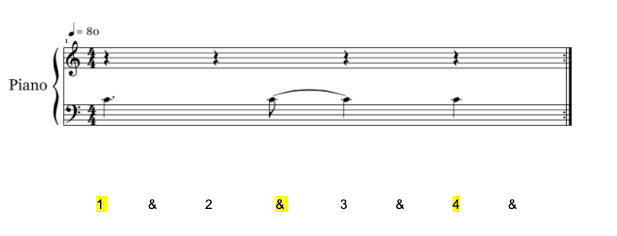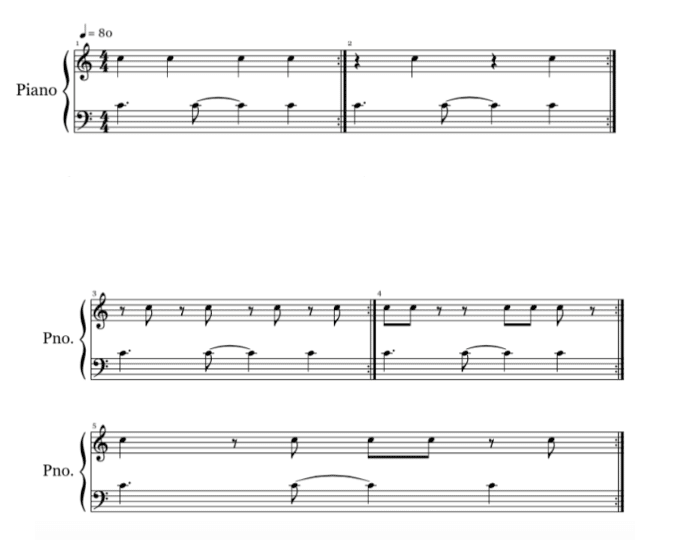Hand independence is one of the biggest struggles that comes with learning piano. As the right hand and left hand are doing pretty much the same thing; pressing keys down, no matter what the rhythm or notes are, it is often hard to differentiate each finger on each hand, resulting in wrong notes being pressed without having a conscious thought about pressing it. There are many different exercises you can practice to develop hand independence and ultimately improve your playing as a pianist.
1. Scalar Exercises
Let’s start with the basics.
To begin with, none of these exercises are going to sound too exciting, but they definitely are the best at improving hand independence.
Start off with your right hand (RH) thumb (finger 1) on C and your pinkie (finger 5). Place your left hand (LH) an octave down from your RH in the same position as your RH (thumb on C, pinkie on G).
All you’re doing is walking your hands up a five note scale making your LH staccato (pressing the note sharp and quickly) and your RH legato (holding the note). Once you’ve mastered this you can swap your hands over. RH playing staccato and LH playing legato.

Following on from this exercise we’re going to change one hand to play eighth notes (quavers). We’re going to make our eighth notes staccato notes whilst keeping our quarter notes (crotchets) as legato.

Once you’ve mastered the RH, try putting the eighth notes in the LH. You might find this much harder! But that’s okay, just keep practicing and you’ll get it.
To fully perfect these exercises it is recommended to do them about 20 – 50 times in one sitting. Even after you’ve perfected them, it’s wise to revisit them every now and again to maintain your skills.
2. Dynamics
This next exercise is a two-handed C Major Scale. However, we’re adding in dynamics to introduce a level of independence. This exercise is a lot harder than first appears and a lot of pianists struggle with playing each hand at different levels.
The first part of the exercise, the right hand is loud (forte) while the left hand is soft (piano). Once you’ve perfected this, switch your hands around to play loud in the LH and soft in the RH.

3. Rhythmic Exercises – New Orleans Rhythm
So once we’ve mastered our Scalar Exercises it’s time to look at rhythm. For our rhythm exercises we’re first going to steal drumming exercises to tap out our rhythms. To develop hand independence we’re going to start with a LH rhythm. Below is a New Orleans LH rhythm.

Start this exercise off by tapping on a table. It’s a bit of a challenging rhythm but a very common one. You’ll be clapping on the highlighted beats 1, 2&, 4.
Now that you’ve mastered the LH we’re going to add in the RH. I will show a bunch of variations of the same theme below to help develop hand independence. Using a metronome and counting out the beats might make these exercises easier.

Once you’ve mastered tapping these out with both hands we’re going to extend this over to the piano. So our bass line remains in the LH and our treble clef in the RH.
Our bass line is playing the notes C E G. For this exercise we’re going to be using a C6 chord (C, E, G, A) in our RH in its first inversion. This means we’re playing E, G, A, C. See below:
:
Our second rhythm exercise is a lot simpler than the New Orleans Rhythm. We’ve simplified the pattern for this so we’re just playing a C 5 Major scale – but if you master this, challenge yourself by playing 2 octaves. This one is tricky because while one hand is moving with at a standard rhythm, the other hand is playing dotted and 8th notes. You’ll notice that the 8th notes don’t align with anything – they’re played in between the quarter notes, and that is the main challenge of this exercise.
Rhythm Exercise 2
3. Articulation
Our final exercise today is a variation on both of our rhythm exercises. Since you’ve already mastered the rhythm aspect of both exercises, we’re going to add in articulation. This is the most difficult of all the exercises because you’re adding in the components from other exercises. One hand is playing staccato (short, detached notes) and slurs in one hand; but not continuous slurs – short slurs that require a break in the sound in each set.
Articulation Exercise 1
The C 5 Major scale is definitely the easier of the two exercises in articulation. We’re going to look at the New Orleans Rhythm again. This time we’re introducing accents (playing a note more prominently than the others). Notice each bar has different notes slurred, staccato and accented. Start off by playing this exercise really slow and then build up the speed as you grow more comfortable with it.
New Orleans Rhythm with Articulation
